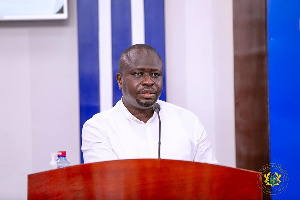 Professor Samuel Kobina Annim, Government Statistician
Professor Samuel Kobina Annim, Government Statistician
The Government Statistician Professor Samuel Kobina Annim, has announced Ghana’s de facto population on Census Night was 30,792,608.
According to him, out of this number, there are 15,610,149 females and 15,182,459 males.
Overall, females make up 50.7% of the population and males 49.3%, giving a national sex ratio of 97 males for every 100 females.
Professor Samuel Kobina Annim disclosed that in all, 8,345,414 households were enumerated, with an average national household size of 3.6 persons.
The latest census also reveals that Greater Accra Region is now the most populous region in Ghana, overtaking the Ashanti Region which has been the most populous region since 1970. Ashanti Region closely follows as the second most populous region. These regions are both almost twice (1.9) times the size of the third most populous region, Eastern Region.
The Central Region is now the fourth most populous region following the splitting of the former Western, Brong Ahafo and Northern Regions who were all more populous than Central Region in 2010. The four most populous regions make up over half (54%) of the total population.
The Ahafo Region is the least populous region taking the place of the Upper West which had been the least populous in all the previous post-independence censuses. The Savannah and North East Regions are the second and third least populous regions respectively.
The current Northern Region observed the largest change in population with an almost 50% increase over its population in 2010. The two other regions that made up the then Northern Region in 2010, North East and Savannah, had the second and third largest intercensal increases (41.7% and 38.4%) respectively.
The next highest change recorded was in Greater Accra with an addition of 35.8%. The Eastern Region, followed by the Volta Region, recorded the lowest intercensal change (adding 10.8% and 11.4% respectively to their populations).